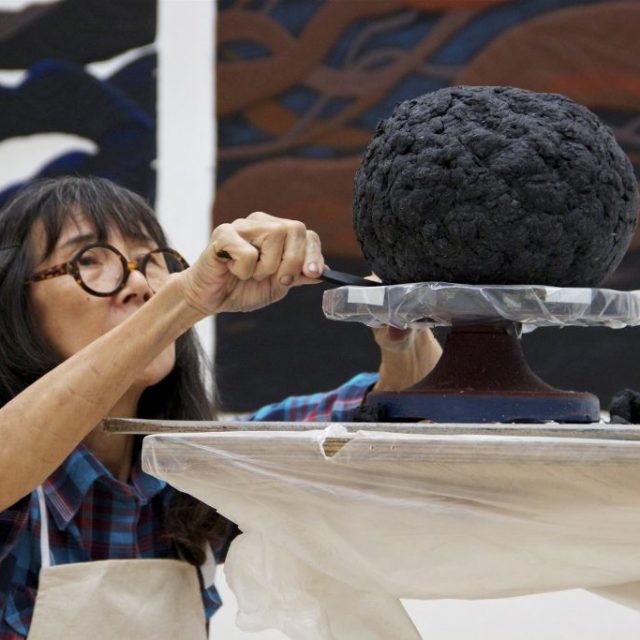From Stone To Paper

On the grounds of the Inland Revenue Authority of Singapore (IRAS) sits Han Sai Por’s “Spring” sculpture – its gush of crystal clear waters energetically and endlessly falls and collects round its barely visible basin; fulfilling its feng shui role of drawing and retaining the nation’s wealth within government coffers.
At the same time, it enduringly symbolizes this renowned Singaporean artist’s signature style; that of skillfully using her dexterous hands to lovingly chisel a gigantic slab of unyielding stone into an even more naturally organic form – one that avails itself as the ‘force or inner life inside struggl(es) to get out’.
Given this instinctive inclination to sculpt, what does Han do when she gleefully accepted an invitation to take up a residency at the Singapore Tyler Print Institute to get intimately acquainted with print and paper making techniques? She sculpts, of course!
Her nibble fingers playfully explores and experiments with the wet paper pulp when it was initially brought to her studio, with the aim of feeling her way to a deeper understanding of how the refreshingly moist paper fibers can be persuaded to dance to her piper’s tunes.
And docilely yield the saturated abaca and cotton fibers did; birthing Han’s daintily miniscule “Tropical Fruit” series. These lusciously crafted mangosteens, chillies and fruit of every nature imaginable along the pleasantly warm equator bear shades of coincidental glimpses of the gigantic granite “Seeds” she had sculpted for exhibition at the National Museum of Singapore (NMS) in 2006.
But while her gigantic “Seeds” had happily slumbered on the grassy lawns at NMS, her “Tropical Fruits” are small enough to gracefully sit on barstool-height pencil-slim black stands. With a great multitude similarly perched, you get a tertiary forest densely populated by ‘trees’ that are joyfully lifting up their dainty fruits of labour to the caressing kisses of the Singapore sun.
Satisfied by the final finish of this almost good-enough-to-eat collection of densely-packed fruit, Han is all set to soar to a higher plane – she immediately proceeds to tear and mold wet paper pulp into her curvaceously wavy larger-than-life size 3-dimensional “Tropical Leaves” and “Flow Through the Land” series.
Her success at making somewhat large stretches of wet combinations of abaca and cotton pulp hold their wavy forms as these papers dry emboldens her to create humongous undulating landscapes that capture a distinctively Japanese or Korean aesthetic. And so a far eastern “Dawn” has subtly “Penetrated” her rolling “Topography” again and yet again.
Obviously, it comes as no great surprise that Han then creatively marries the molding techniques from her “Tropical Fruit” and “Flow Through the Land” series with that used to craft “Topography”. The delectable end result is a series she evocatively calls “Erosion”. Here, miniscule hard-as-rock pebbles are suspended in a cascading flow down a femininely bulbous burrow in soft pliable ground: looking at these luscious pieces of art, I can almost hear the joyful trickle of falling water in her “Spring” outside IRAS.
Now that Han has paper making eating out of the palm of her hand, she proceeds to ‘pencil’ the wet pulp with swirling coils of coloured threads; mimicking the undulating directional flows of the welcome breezes that sweep across her little tropical island home. And so her collection of artwork personifying “Fly Through the Wind” is born.
Then and only then does Han merrily move on to explore using the more conventional woodblock printing along with paper pulp painting. Even then the resulting “Rooted & Nestles” series draws from a harmoniously matrimony of Japanese graphics with a Zen finish of the natural subject matter.
And that I believe is the essence of Han’s creative spirit – she lends to all her artistic adventures a deep rootedness to the natural: she intuitively sculpts what comes from or grows out of the ground in sincere homage to mother earth.
Hear Han’s homeland call her name at the Singapore Tyler Print Institute at 41 Robertson Quay, Singapore 238236 before her exhibition ends on 22 February this year.
 Singart
Singart
